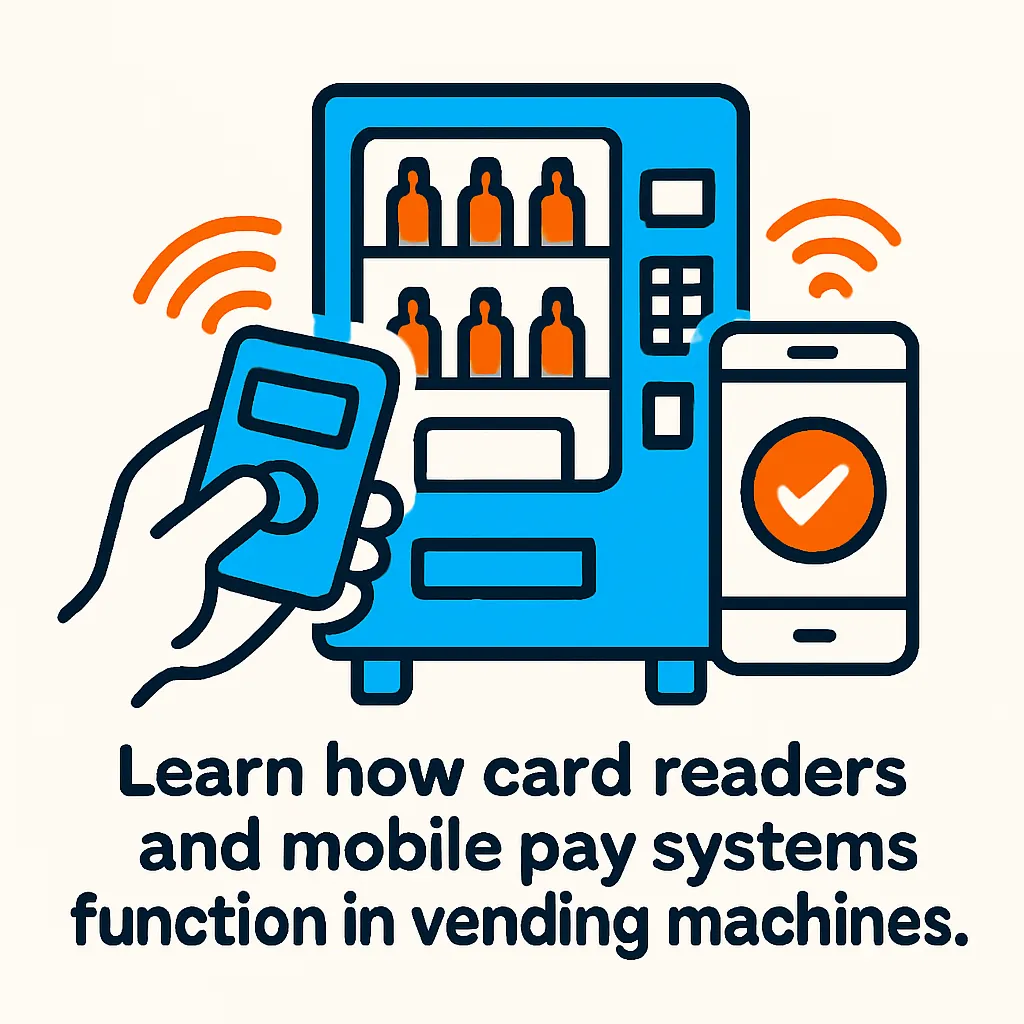How Does Cashless Vending Work?
Learn how card readers and mobile pay systems function in vending machines.
Back to Vending FAQs ResourcesLearn how card readers and mobile pay systems function in vending machines.
Back to Vending FAQs ResourcesCashless vending machines are revolutionizing the way customers purchase snacks and beverages, offering seamless transactions and enhanced user convenience through advanced payment technology.
![]() Accepts credit/debit cards, mobile payments, and digital wallets
Accepts credit/debit cards, mobile payments, and digital wallets
![]() Provides secure and reliable transaction processing for every purchase
Provides secure and reliable transaction processing for every purchase
![]() Enhances customer satisfaction by eliminating the need for exact change
Enhances customer satisfaction by eliminating the need for exact change

Modern vending machines have evolved significantly from their coin-only predecessors. The advent of cashless vending has transformed the user experience, making purchases faster, more convenient, and more secure. But how exactly does this technology work? At its core, cashless vending relies on integrated payment systems that communicate digitally with banking networks to process transactions.
The most common form of cashless payment involves credit and debit cards. Vending machines equipped with card readers feature magnetic stripe readers, EMV chip slots, and increasingly, NFC (Near Field Communication) capabilities for tap-to-pay functionality. When a user inserts, swipes, or taps their card, the reader captures the card data. This information is then encrypted and transmitted over a secure cellular or Wi-Fi network to a payment processor. The processor verifies the card's validity, checks for sufficient funds, and approves or declines the transaction. This entire process typically takes mere seconds.
Beyond physical cards, cashless vending also embraces mobile payment solutions such as Apple Pay, Google Pay, and other digital wallets. These systems leverage NFC technology. When a user taps their smartphone or smartwatch near the NFC reader, the device transmits encrypted payment information to the machine. Similar to card transactions, this data is sent to a payment processor for verification. The convenience of not needing a physical wallet or exact change makes mobile payments a highly popular option, especially among younger demographics and in fast-paced environments. The rise of AI vending coolers further integrates this touchless experience, often without even requiring an explicit tap.
For cashless payment systems to function effectively, reliable connectivity is paramount. Most cashless vending machines utilize integrated modems that connect to cellular networks (like 4G or 5G) or local Wi-Fi networks. This constant connection not only facilitates real-time payment processing but also enables advanced telemetry features. Telemetry allows operators to remotely monitor inventory levels, track sales data, identify popular products, and receive alerts for machine malfunctions. This data-driven approach significantly improves operational efficiency, reduces downtime, and ensures machines are always stocked with desired items. This level of insight helps vending companies tailor their offerings and service routes, ensuring customer satisfaction and maximizing profitability, much like what is learned in tools and software for vending businesses.
In summary, cashless vending systems harness secure digital communication, advanced reader technology, and robust connectivity to provide a seamless and efficient purchasing experience. This innovation benefits both consumers, with added convenience and payment flexibility, and businesses, through streamlined operations and valuable data insights.
Cashless vending refers to vending machines that accept payments primarily through electronic methods like credit/debit cards, mobile wallets, and other digital payment platforms, rather than cash or coins.
These machines are equipped with card readers (for EMV chip, swipe, and tap-to-pay) and/or NFC scanners for mobile payments like Apple Pay or Google Pay. The payment is processed securely through a connected network.
Most cashless vending machines accept major credit and debit cards (Visa, MasterCard, Amex, Discover), as well as mobile payment apps such as Apple Pay, Google Pay, and sometimes proprietary vending apps.
Yes, cashless vending generally offers enhanced security. It reduces the risk of cash theft or vandalism for cash boxes and transactions are digitally encrypted. It also eliminates issues with exact change or jammed currency.
Yes, for real-time transaction processing and inventory management, cashless machines typically require a reliable internet connection, often via cellular data or Wi-Fi.
Benefits include increased sales (as users are not limited by cash on hand), improved transaction security, remote monitoring of inventory and sales data, and reduced operational costs associated with cash handling.
Potential downsides include reliance on internet connectivity, transaction fees for payment processing, and the exclusion of customers who prefer or can only pay with cash.
Many modern machines are hybrid, meaning they can accept both cashless payments and traditional cash/coin, offering maximum flexibility to users.
Telemetry systems allow operators to track sales data, inventory levels, and machine status in real-time from a remote location, enabling efficient restocking and maintenance schedules.
Cashless vending is highly suitable for locations with good network coverage and a customer base accustomed to digital payments. It's especially popular in offices, schools, and public venues.